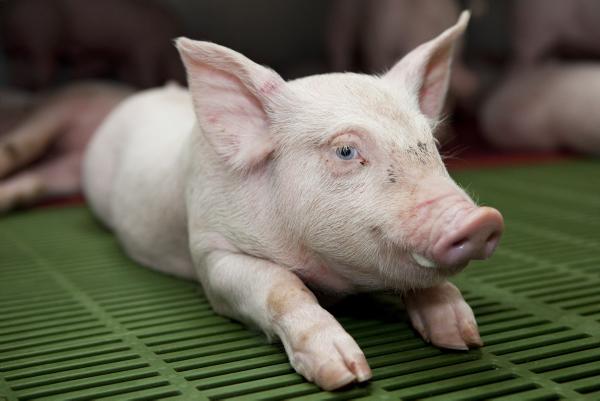9 July 2018
Gene modification: How it could save the pig industry billions
Posted by Shane Hanlon
This is part of a series of posts from our own Shane Hanlon’s disease ecology class that he’s currently teaching at the University of Pittsburgh Pymatuning Laboratory of Ecology. Students were asked to write popular science posts about (mostly) wildlife diseases. Check out all the posts here.

Credit: Wiki Commons
By Josh Epps Forst
Scientists have recently produced pigs with the ability to resists a highly problematic and costly disease. Porcine Reproductive and Respiratory Syndrome (PRRS) is a pathogenic disease that infects pigs, and it ultimately causes the industry to lose approximately $2.5 billion in revenue annually. When young pigs are infected with PRRS, respiratory and appetite problems can lead to an increased chance of death. Also, pregnant mothers infected with the disease have a much higher chance of losing their litter entirely. The significant damage that PRRS causes to these pigs themselves as well as the industry’s profitability has lead to research into potential solutions to minimize PRRS.
There are currently no effective treatments for PRRS once it has already infected its host. Antibiotics as well as appetite stimulants have shown minimal benefits in PRRS infected pigs. Therefore, most research efforts today are concentrated on disease prevention instead of disease treatment. Some standard viral prevention methods are used with varying levels of success. Proper isolation and acclimatization of pigs into new populations is key to help minimize the risk of PRRS infection. Multiple tests are also done on pigs while in isolation and before their introduction into the herd. These methods do help to minimize PRRS infection, but the pathogen still manages to infect a significant portion of pigs globally. Also, PRRS vaccines are mostly Clearly, scientists must find other more effective preventative methods.
Genetic modification had the potential to offer a real and permanent solution to the PRRS epidemic. Researchers observed the virus in a lab setting and determined the gene it targets in pigs. They hypothesized that the removal of a certain portion of this gene that accepts the virus could lead to PRRS immune pigs. Removal of only a portion of the gene receptor is important, since removing the entire receptor could be detrimental for the animal. Previous studies have shown that this modified gene was resistant to the PRRS virus in a lab setting, but this was the first time that pigs with the modified gene were actually introduced to the virus. Results are very promising. None of the genetically modified pigs introduced to the pathogen became infected, and blood samples returned negative as well.
Even though this is a promising discovery for the pig industry’s attempt to minimize PRRS, there is quite a bit of research and other boundaries that need to be broken. Researchers need more extensive analysis to confirm that the genetic modifications do not harm the animals in the long-term. Once this is complete, there are still barriers. Genetically modified food is a controversial subject, so policy makers as well as the public would need to be informed and convinced of the benefits and need for genetic modification in pig populations. If this is successful, than scientists could begin a mass introduction of the modifications into pig populations.
Sources:
https://www.sciencedaily.com/releases/2018/06/180620150139.htm
https://www.merckvetmanual.com/generalized-conditions/porcine-reproductive-and-respiratory-syndrome/overview-of-porcine-reproductive-and-respiratory-syndrome


 The Plainspoken Scientist is the science communication blog of AGU’s Sharing Science program. With this blog, we wish to showcase creative and effective science communication via multiple mediums and modes.
The Plainspoken Scientist is the science communication blog of AGU’s Sharing Science program. With this blog, we wish to showcase creative and effective science communication via multiple mediums and modes.